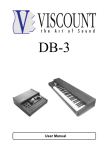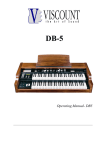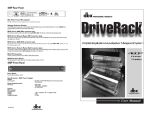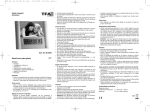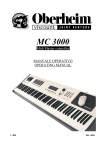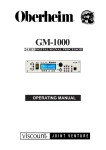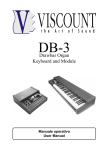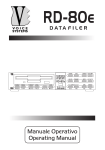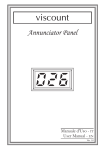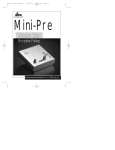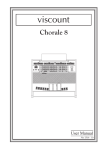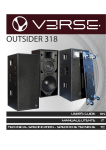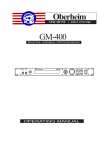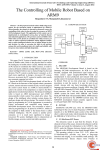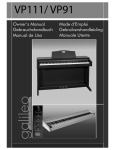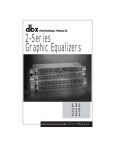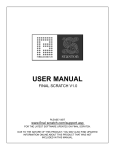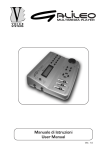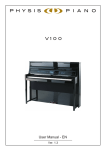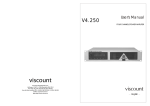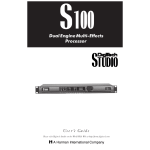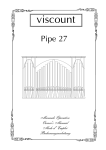Download Viscount Opera user manual
Transcript
User Manual Opera Digital Piano WARNING: READ THIS FIRST! ∗∗∗ AVIS IMPORTANT! WARNING RISK OF ELECTRIC SHOCK DO NOT OPEN AVIS RISQUE DE CHOC ÉLECTRIQUE NE PAS OUVRIR This symbol is intended to alert the user to the presence of uninsulated “dangerous voltage” within the product’s enclosure that may be of sufficient magnitude to constitute a risk of electric shock to persons. This symbol is intended to alert the user to the presence of important operating and maintenance (servicing) instructions in the literature accompanying the appliance. Ce simbole sert pour avertir l’utilisateur qu’à l’interieur de ce produit sont présents éléments non isolés soumis à “tensions dangereuses” suffisants à créer un risque d’électrocution. Ce simbole sert pour avertir l’utilisateur qu’à l’interieur de la documentation de l’appareil sont présentes importantes instructions pour l’utilisation correcte et la manutention de l’appareil. ATTENTION CAUTION TO REDUCE THE DANGER OF ELECTRIC SHOCK DO NOT REMOVE COVER (OR BACK) NO USER-SERVICEABLE PARTS INSIDE REFER SERVICING TO QUALIFIED SERVICE PERSONNEL AFIN D’EVITER LES RISQUES DE CHOC ÉLECTRIQUE: NE PAS OUVRIR LE COUVERCLE (OU PANNEAU ARRIERE) L’UTILISATEUR NE PEUT EFFECTUER AUCUNE REPARATION PUOR TOUTE REPARATION EVENTUELLE, FAIRE APPEL A UN PERSONNEL QUALIFIE “INSTRUCTIONS PERTAINING TO A RISK OF FIRE, ELECTRIC SHOCK, OR INJURY TO PERSONS” IMPORTANT SAFETY INSTRUCTIONS WARNING: 1) Read these instructions. 2) Keep these instructions. 3) Heed all warnings. 4) Follow all instructions. 5) Do not use this apparatus near water. 6) Clean only with dry cloth. 7) Do not block any ventilation openings. Install in accordance with the manufacturer’s instructions. 8) Do not install near any heat sources such as radiators, heat registers, stoves, or other apparatus (including amplifiers) that produce heat. 9) Do not defeat the safety purpose of the polarized or grounding-type plug. A polarized plug has two blades with one wider than the other. A grounding type plug has two blades and a third grounding prong. The wider blade or the third prong are provided for your safety. If the provided plug does not fit in to your outlet, consult an electrician for replacement of the obsolete outlet. 10) Protect the power cord from being walked on on pinhead, particularly at plugs, convenience receptacles, and the point where they exit form the apparatus. 11) Only use attachments/accessories specified by the manufacturer. 12) Use only with the cart, stand, tripod, bracket, or table specified by the manufacturer, or sold, with the apparatus. When a cart is used, use caution when moving the cart/apparatus combination to avoid injury from tip-over. 13) Unplug this apparatus during lightning storms or when unused for long periods of time. 14) Refer all servicing to qualified service personnel. Servicing is required when the apparatus has been damaged in any way, such ad power-supply cord or plug is damaged, liquid has been spilled or objects have fallen into the apparatus, the apparatus has been exposed to rain or moisture, does not operate normally, or has been dropped. SAVE THESE INSTRUCTIONS ∗∗∗ INSTRUCTIONS A CONSERVER VISCOUNT Opera Digital Piano Index Chapter One - Specifications ............................................................... 25 Panel Description ..................................................................... 25 Side Panel ................................................................................ 30 Chapter Two - Use: Basic Functions .................................................... 31 Turning on ................................................................................ Demo ....................................................................................... 2nd (LAYER mode) (Overlapping timbres) ............................... SPLIT (Dividing the keyboard into zones) ................................ 31 31 32 33 Chapter Three - Use: Saving to memory ............................................. 34 Assigning a name to the memory selected .............................. 34 Recalling and playing back a memory ..................................... 35 Chapter Four - The UTILITY mode functions ...................................... 35 EQUALIZER function ............................................................... TRANSPOSER function ........................................................... DYNAMIC CURVE function ..................................................... TEMPERAMENT function ........................................................ PEDAL EXCLUSION function .................................................. EXPR PEDAL SETUP function ................................................ BASS SETTING function ......................................................... MIDI functions .......................................................................... MEMORY NAME function ........................................................ DELETE SONG function .......................................................... RECORDER function ............................................................... Opeating Manual 36 37 37 38 38 39 39 40 41 43 43 23 VISCOUNT Opera Digital Piano 24 Operating Manual VISCOUNT Opera Digital Piano Chapter One Specification The VISCOUNT Opera Digital Piano is a digital piano equipped with a dynamic keyboard which guarantees an action exactly the same as that found on normal acoustic pianos. This is achieved by the use of a mechanical hammer system underneath the piano key. The acoustic piano presets have been created by meticulously and scrupulously sampling some of the best makes of grand piano in the world today. The high sound quality of the VISCOUNT Opera Digital Piano makes it an ideal instrument for both personal study and professional use. The VISCOUNT Opera Digital Piano is not just a digital piano however: certain features have been incorporated which make it possible to transform the instrument into a whole orchestra, to play different sounds together, and to record and playback pre-recorded compositions. Panel description PRESETS/MEMORY SECTION: used to select sounds or to store them to memory PRESET KEYS: (Acoustic piano 1) (Harpsichord) (Acoustic piano 2) On each of these keys it is possible to load a series of preset sounds stored in an internal Rom library. (Electric piano 1) (Electric piano 2) Opeating Manual 25 VISCOUNT Opera Digital Piano (Vibes) (Brass) (Acoustic guitar with nylon strings) (Jazz Organ) (Strings) (Acoustic bass) (Choir) on this key it is possible to load a preset sound stored in an internal Rom library. ACOUST. BASS ELECTR. BASS FRETTLES BASS PAD BASS HORN BASS STRING BASS GUITAR BASS List of library sounds PIANO 1 PIANO 2 PIANO 3 E. PIANO 1 E. PIANO 2 E. PIANO 3 RHODES 2 HARPSICHORD VIBES MARIMBA NYLON GUITAR JAZZ GUITAR STRINGS 1 STRINGS 2 CHOIR BRASS SYNTH HORN JAZZ ORGAN 1 JAZZ ORGAN 2 JAZZ ORGAN 3 PIPE ORGAN SYNTH PAD STANDARD SET BRUSH SET this key is used to access the MEMORY function. The VISCOUNT Opera Digital Piano has a series of memory locations where all the voices complete with their various parameters as described below can be stored, together with any ambient effects and modulations assigned to them. There are 16 memory locations available, the same as the number of Presets/Memories including those for the bass and the various Custom Voices. this key turns on the SECOND VOICE function. The 2nd VOICE key allows a second voice to be either layered over the main one or the keyboard to be split into two separate voice parts. 26 Operating Manual VISCOUNT Opera Digital Piano SPLIT/UTILITIES SECTION: allows the split point to be chosen and various keyboard parameters to be set. SPLIT/UTILITIES KEYS: this key gives access to the SPLIT mode. SPLIT mode means that the keyboard can be divided into two zones and a different voice can be assigned to each zone. this key gives access to the UTILITY mode. In the UTILITY mode the following operations are possible: equalize a timbre, set transposition parameters, set the type of dynamic curve to be applied to the voices, select different types of tuning, control the instrument MIDI data, save memory data, exclude either one or all three of the normal pedal functions from either of the two voices, assign a name to the memory selected. CURSOR key. When the display contains more than one parameter, the CURSOR key is used to select the one you require. EXIT key. Returns the instrument to the PLAY mode or to the previous display. Opeating Manual 27 VISCOUNT Opera Digital Piano +/YES key. Used to increase the parameter selected by one step, to scroll through the voices contained in the library and to give affirmative responses to the messages which appear. -/NO key. Used to decrease the parameter selected by one step, to scroll through the voices contained in the library and to give negative responses to the messages which appear. EFFECTS SECTION: Allows the various ambient effects stored in the memory to be selected. EFFECTS SECTION HALL key. HALL Effect . ROOM key. ROOM Effect. When these keys are kept pressed down a menu containing LEV (Level) and TME (Time) settings will appear which can be used to personalize the effects stored to memory. 28 Operating Manual VISCOUNT Opera Digital Piano Any modifications made will remain in the memory even when the instrument has been turned off. Press EXIT to return to the PLAY mode. C.EFF.1 Key. When the C.EFF.1 key is held down longer, a list of the ambient effects available will appear on the display. The effects held in the internal library are the following: ROOM LARGE ROOM 1 LARGE ROOM 2 MEDIUM HALL 1 MEDIUM HALL 2 LARGE HALL 1 LARGE HALL 2 CHAMBER 1 CHAMBER 2 PLATE REVERB SPRING REVERB DELAY MULTITAP DLY The following parameters can be modified using the cursor key with the INC and DEC keys: CHORUS key. CHORUS modulation effect. TREMOLO key. TREMOLO modulation effect. Just like in the ambient effect section, the settings in the modulation effects section can also be personalized. The RTE (RATE) and DPT (DEPTH) parameters can be modified for the CHORUS effect, while for the TREMOLO effect SPD (SPEED) and DPT (DEPTH) can be changed. C. EFF. 2 Key. When the C.EFF.2 key s held down longer, a list of the modulation effects available will Opeating Manual 29 VISCOUNT Opera Digital Piano The effects held in the internal library are the following: AUTO PAN POT CHORUS CROSS-PAN FLANGER MONO PHASE STEREO PHASE TREMOLO VIBRATO VIBRATO SCAN ROTARY SLOW ROTARY FAST The cursor key and the INC and DEC keys can be used to modify the following parameters: The ROTARY effect cannot be selected in section 1 and section 2 at the same time. RECORDER SECTION: to record and play back songs. RECORDER Key. PLAY/STOP Key. This key gives access to the sequencer functions (a sort of “digital recording”). In addition to this, by pressing SONG+PLAY/STOP at the same time, the demo songs stored in the instrument can be played back. Side Panel 30 Operating Manual VISCOUNT Opera Digital Piano Chapter Two Use: Basic functions Turning on Make sure the MASTER VOLUME slider is set to Ø. Turn on the POWER switch. After a few seconds a brief instrument presentation message will appear on the screen. Adjust the volume using the MASTER VOLUME slider. Demo Press the the display: and keys at the same time. The following message will appear on After a few seconds you will be able to hear a demo song created using some of the instrument’s most interesting timbres. When the the following: and keys are pressed at the same time the display will change to You will be able to hear a “technical” DEMO, that is to say the sampled sound of the hammers as they hit the keys and are released, as well as the sound produced by the piano string frame when the DAMPER pedal is pressed. Press the key to exit the DEMO mode. Opeating Manual 31 VISCOUNT Opera Digital Piano Once the instrument has been turned on and after the brief presentation message, the VISCOUNT Opera Digital Piano goes into the PLAY mode and the display will show the following message: MEMORY N.: 1 Grand Piano 1 The instrument is ready to play. To hear the other voices press the keys in the PRESETS/MEMORIES section. 2nd (LAYER mode) (Overlapping timbres) When this key is pressed it is possible to select a second voice to be layered on top of the first one chosen. Example: layering a piano voice over strings. It has already been pointed out that when the VISCOUNT Opera Digital Piano, is turned on, after a brief introductory message, it goes into the PLAY mode (allowing one voice at a time to be played throughout the whole length of the keyboard). The display shows the following message: 1st:Piano 1 VOL:110 REV:16 When the key is pressed the display will show: V:0 R:0 Select STRINGS 1 and the display will then change to: It will now be possible to hear (play) a piano sound together with a string voice. 32 Operating Manual VISCOUNT Opera Digital Piano A modulation effect can be assigned to the second voice by simply pressing the keys CHORUS, TREMOLO or SPLIT. Try experimenting with all the different combinations. SPLIT (Dividing the keyboard into zones) The key allows the keyboard to be divided into two zones and a different voice can now be assigned to each zone. Example: 1st 2nd The bass has its own independent and programmable SPLIT (separation) point. To change the SPLIT point hold down the SPLIT key for a few seconds. The following message will appear on the display: The cursor will move to parameter B4, which is the factory set (default) split point (this means that from CØ to B3 a bass voice can be played with, for example, a piano voice from C4 to G9). To modify the parameter use the value using keys and key to move to the field required and enter the new . To assign a voice to the right zone press and select the voice you want. If you like the layering or split setup your have created, it can be saved to one of the instrument’s 16 memory locations (and which originally contained demo patches when the instrument was sent out from the factory). Opeating Manual 33 VISCOUNT Opera Digital Piano Chapter Three Use: Saving to memory Keep the the display: key pressed down for a few seconds. The following message will appear on The key and the keys in the PRESETS/MEMORIES section will start flashing. Press the key for the memory where you want to save the set up. The display will now look like this: Press the key to confirm the save to memory operation. If on the other hand the key is pressed, the message MEMORY NOT SAVED will appear on the display briefly and the instrument will automatically return to the PLAY mode. Assigning a name to the memory selected Press the key. By using the +1/YES and -1/NO keys it is possible to scroll through the list of all the functions available. Select the MEMORY NAME function. Press the using the 34 key and the and key. Enter the name of the memory keys. Operating Manual VISCOUNT Opera Digital Piano The name entered will automatically be memorized when you exit the UTILITY mode by pressing the key. Recalling and playing back a memory Press the key and the key in the PRESETS/MEMORIES section where the memory you want to recall is located. The following message will appear on the display : MEMORY N.: 1 Grand Piano 1 The instrument will take just a few seconds to load the memory selected. Chapter Four The UTILITY MODE functions The UTILITY mode features various functions which allow you to modify the general instrument voice parameters. The functions available are the following: 1) EQUALIZER 2) TRANSPOSER 3) DYNAMIC CURVE 4) TEMPERAMENT 5) PEDAL EXCURSION 6) EXPR PEDAL SETUP 7) BASS SETTING 8) MIDI Opeating Manual 9) MEMORY NAME 10) DELETE SONG 35 VISCOUNT Opera Digital Piano EQUALIZER Function After pressing the key and having selected the Equalizer parameter using the and keys, the following display will appear: By pressing the parameters. key you will be able to enter the EQUALIZER mode and modify the By pressing the key you will be able to scroll forwards through the other UTILITY mode functions one step at a time. By pressing the key you will be able to scroll backwards through the other UTILITY mode functions one step at a time. By pressing the key you will exit the UTILITY mode. This display is common to all mode UTILITY functions. By pressing the key you will be able to access the parameter entry field of the EQUALIZER function. The display will show the following message: The first line (EQUALIZER: ALL) contains the field which determines whether the operation is to affect all the voices (ALL), the first voice (1st), or the second voice (2nd). Press the and Using the key it will be possible to move to the LOW and HIGH tone fields. 36 keys to select ALL, 1st or 2nd. Operating Manual VISCOUNT Opera Digital Piano Each tone has 16 steps (8 positive steps and 8 negative steps). Values are entered in the LOW and HIGH fields using the Press the and keys. key to exit this field. TRANSPOSER Function After having selected the TRANSPOSER function from the UTILITY menu press the key. The display will show the following message: As in the EQUALIZER mode, the first line (TRANSPOSER: ALL) contains the field which determines whether the operation is to affect all voices (ALL), just the first voice (1st), just the second voice (2nd) or just the bass voice (bss). Using the key we move to the coarse parameter field, where the sounds can be transposed by one octave. The range of this transposition is in fact +/- 12 semitones. The “fine” field is used for fine tuning, expressed in hundredths of a semitone or “cents”. The range is +/- 127 cents. DYNAMIC CURVE Function This function is used to define the type of dynamic curve to be applied to the voices. As in the TRANSPOSER mode, the first line (TRANSPOSER: ALL) contains the field which determines whether the operation is to affect all voices (ALL), just the first voice (1st), just the second voice (2nd) or just the bass voice (bss). Opeating Manual 37 VISCOUNT Opera Digital Piano There are up to 10 dynamic curves to choose from: FLAT Value: 64 EXTRA LIGHT LIGHT MEDIUM LIGHT FEEL LIGHT LINEAR FEEL WEIGHT MEDIUM HEAVY HEAVY EXTRA HEAVY This function allows a more expressive performance to be achieved. The function is not applicable to the Organ and Harpsichord voices because the algorithm which generates them does not accept dynamic information and the assigning of a dynamic curve. TEMPERAMENT Function This function is used to select different types of tuning (temperament) from those most commonly used: EQUAL PYTHAGOREAN VALLOTTI MEANTONE WERCKMEISTER KIRNBERGER The display will show the following message: The and keys can be used to select the different tunings. PEDAL EXCLUSION Function This function allows the action of one or all three of the pedals to be excluded for either of the two voices. 38 Operating Manual VISCOUNT Opera Digital Piano The display will show the following message: To access the 1st or 2nd fields press the key and the and keys. Do the same to access the NONE, SOFT, SOSTENUTO, DAMPER, ALL fields. EXPR PEDAL SETUP Function After selecting the EXPR PEDAL SETUP function, press the sage will appear on the display: key. The following mes- The VISCOUNT Opera Digital Piano is equipped with a multi-function pedal. The first field (INT) is used to enable the function omitted by the expression control. The second field (EXT) allows a standard control change selected to be assigned or initiated (the first field must be set to off). The Control Change is sent out from the MIDI OUT port and can be used to control an external unit connected via MIDI to the instrument. The control change value cannot be preset but will be read, in real time, by the pedal range. BASS SETTING Function Once BASS SETTING has been selected from the UTILITY menu, press the proper key . The following message will appear on the display : The first field defines how the bass voices are to operate. Choices are POLY or MONO. Opeating Manual 39 VISCOUNT Opera Digital Piano The second field, containing two choices, OVERLAP and REPLACE, concerns the SPLIT mode and these define how the bass voice is to be applied within the range assigned. OVERLAP allows the bass voice to be combined with the section voice within the split range. REPLACE substitutes the bass voice for the voice which was programmed in the split mode up to the set split. MIDI Functions This UTILITY mode function is used to edit the various MIDI functions listed below: CHANNEL IN FILT OUT FILT DYNAMIC NOTE PG SEND CC SEND OUT CC ON PEDALS DUMP To scroll through the list of various MIDI functions, after pressing the key, press the and keys. The CHANNEL function is used to set the MIDI channel, for transmitting and receiving data regarding 1st VOICE, 2nd VOICE and BASS. The CHANNEL function display is as follows: The range of the 1st, 2nd and BASS fields is 1-9, OFF 11-16. Channel 10 is not enabled because in GM standard this channel is assigned to the rhythm parts. After placing the cursor on the arrow and pressing the as follows: 40 Operating Manual key, the next display will appear VISCOUNT Opera Digital Piano The IN FILTER function allows you to “filter” certain information entering the instrument. The NOTE, PROGRAM CHANGE (PF) and CONTROL CHANGE (CC) field in the IN FILTER function can be enabled or disabled. After placing the cursor on the arrow and pressing the will appear as follows: key, the next display, OUT FILT, This function allows you to turn on or off certain MIDI data sent out from the instrument such as NOTE, PROGRAM CHANGE (PG) and CONTROL CHANGE (CC). The next display is used to determine whether or not the DYNAMIC NOTE OFF function is transmitted: This function allows to send or not the MIDI code of the Note Off Velocity. The PG SEND function allows a BANK and PROGRAM CHANGE message to be sent via MIDI. The first field (PG SEND) is for the Program Change number you wish to send. The second field (BH) is for the control change value which identifies the bank change (CC OO), while the third field (BL) is for the bank number you wish to select. Moving the cursor to the arrow and pressing the proper key display. Opeating Manual , will call up the following 41 VISCOUNT Opera Digital Piano CONTROL CHANGE ON PEDALS: this function allows a control change to be assigned to one of the three pedals and to save the setting to memory. The following message will appear on the display . N.B. Control Changes enabled for this purpose can only work as ON/OFF switches for uses such as turning on or off the chorus effect on external devices, turning the portamento effect on or off etc... Moving the cursor to the arrow and pressing the key, will call up the following display. The DUMP function allows you to save the contents of the whole memory. The following message will appear on the display: MEMORY NAME Function This function is used to give a name to the memory selected. The display will show the following message: To enter the name just press the proper key and keys to choose the letter required. The name will automatically be stored to memory when you exit the UTILITY mode by pressing the (EXIT) key. 42 Operating Manual VISCOUNT Opera Digital Piano DELETE SONG Function This function allows you to delete a song recorded previously. After selecting the DELETE SONG function from the UTILITY menu, press the appear on the display : key. The following message will Select the song you wish to delete using the execute the operation. keys and press the and key to RECORDER Function The VISCOUNT Opera Digital Piano is equipped with a two-track RECORDER which allows 2 or 3 songs of a reasonable length to be recorded. To access the RECORDER mode press the key. The while the following message appears on the display : key will start flashing The Mode field: indicates the current mode, PLAY or REC. SONG is used to define the song you wish to hear or record. M is for the metronome. The M=off field means that the metronome is turned off and will not be heard when recording or during playback. M=Play means that the metronome will only be on during playback, while M=Rec means it is only on during recording. M=Alw means the metronome is always on, during both recording and playback. Opeating Manual 43 VISCOUNT Opera Digital Piano The 4/4 field gives the TIME SIGNATURE. The 12 most common time signatures from 4/4 to 12/8 are available. T=120 gives the tempo of the SONG. The range goes from 32 to 250. To record a song, put the cursor on the MODE field and select REC using the keys. and Now select the SONG you wish to record (SONG 1, 2 or 3) and enter the appropriate metronome, time signature and tempo settings. Press the key to start recording. The MODE field: will show Recording..... Press the key to stop recording. The MODE field: will show PLAY. By pressing the recorded song. To exit the RECORD mode press the 44 key. Operating Manual key again you can playback the CAUTION! This product contains a lithium battery. There is danger of explosion if battery is incorretly replaced. Replace only with a Maxell CR2032. Replace only with the correct polarity. Discard used battery according to manufacter’s instruction’s. ADVARSEL! Lithiumbatteri – Eksplosjonsfare. Vade utksifting benyttes kun batteri som anbefalt av apparatfabrikanten. Brukt batteri returneres apparatleverandøren. ADVARSEL! Lithiumbatteri - Eksplosjonsfare ved fejlagtig håndtering. Udskiftning må kun ske med batteri av samme fabrikat og type. Levér det brugte batteri tilbage til leverandøren. VAROITUS! Paristo voi räfähtää, jos se on virheellisesti asennettu. Vaihda paristo ainoastaan laitevalmistajan suosittelemaan tyyppin. Hävitä käytetty paristovalmistajan ohjeiden mukaisesti. WARNING! Explosionsfar vid felaktigt batteribyte. Anväd samma batterityp eller en ekvivalent typ som rekommendars av apparatillverkaren. Kassera använt batteri enlight fabrikantens istructions. The information contained in this manual is subject to change at any time without notification. Some information contained in this manual may also be inaccurate due to undocumented changes in the product or operating system since this version of the manual was completed. The information contained in this version of the owner’s manual supercedes all previous version. NOTE: This equipment has been tested and found to comply with the limits for a Class B digital Device, persuant to Part 15 if the FCC Rules. These limits are designed to provide reasonable protection against harmful interference in a residential installation. This equipment generates, uses and can radiate radio frequency energy and, if not installed and used in accordance with the instruction, may cause harmful interference to radio comunications. However, there is no guarantee that the interference will not occur in a particular installation. If this equipment does cause harmful interference to radio or television reception, which can be determinated by turning the equipment off and on, the user is encuraged to try to correct the interference by one or more of the following measures: - Reorient or relocate the receiving antenna. Increase the separation between the equipment and receiver. Connect the equipment into an outlet on a circuit different from that to which the receiver is connected. Consult the dealer or an experienced Radio/Tv technician for help. The user is cautioned that any changes or modification not expressly approved by the party responsable for compliance could void the user’s authority opearate the equipment. Sales Division: Via Belvedere Fogliense 8, I-47836 Mondaino (RN) Italy tel.+39-0541-981700 - fax +39-0541-869605 e-mail: [email protected] - Internet: www.viscount-organs.com - www.viscount.it Distribution for Italy: TITAN MUSIC S.A. Strada Genghe di Atto, 80 - 47031 Acquaviva – Repubblica di San Marino tel.0549-999164 - fax 0549-999490 e-mail: [email protected] - Internet: www.viscount-organs.com - www.viscount.it


























